Signal coupling
PARTS AND MATERIALS
-
6 volt battery
-
One capacitor, 0.22 �F (Radio Shack
catalog # 272-1070 or equivalent)
-
One capacitor, 0.047 �F (Radio Shack
catalog # 272-134 or equivalent)
-
Small "hobby" motor, permanent-magnet type
(Radio Shack catalog # 273-223 or equivalent)
-
Audio detector with headphones
-
Length of telephone cable, several feet
long (Radio Shack catalog # 278-872)
Telephone cable is also available from
hardware stores. Any unshielded multiconductor cable will
suffice for this experiment. Cables with thin conductors
(telephone cable is typically 24-gauge) produce a more
pronounced effect.
CROSS-REFERENCES
Lessons In Electric Circuits, Volume
2, chapter 7: "Mixed-Frequency AC Signals"
Lessons In Electric Circuits, Volume
2, chapter 8: "Filters"
LEARNING OBJECTIVES
-
How to "couple" AC signals and block DC
signals to a measuring instrument
-
How stray coupling happens in cables
-
Techniques to minimize inter-cable
coupling
SCHEMATIC DIAGRAM

ILLUSTRATION
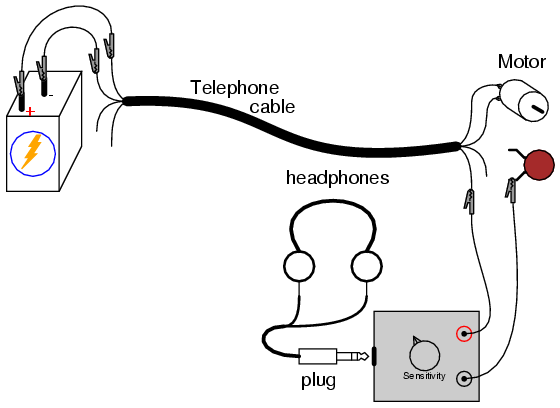
INSTRUCTIONS
Connect the motor to the battery using two
of the telephone cable's four conductors. The motor should
run, as expected. Now, connect the audio signal detector
across the motor terminals, with the 0.047 �F capacitor in
series, like this:
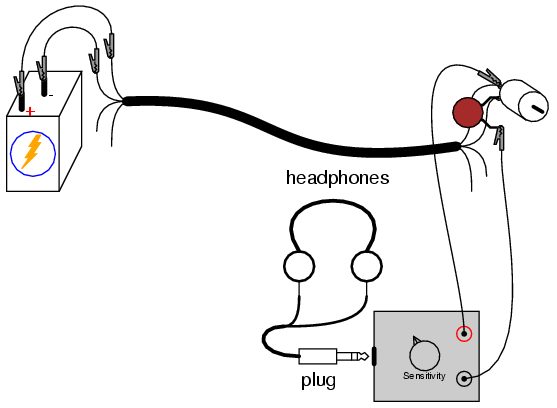
You should be able to hear a "buzz" or
"whine" in the headphones, representing the AC "noise"
voltage produced by the motor as the brushes make and break
contact with the rotating commutator bars. The purpose of
the series capacitor is to act as a high-pass filter, so
that the detector only receives the AC voltage across the
motor's terminals, not any DC voltage. This is precisely how
oscilloscopes provide an "AC coupling" feature for measuring
the AC content of a signal without any DC bias voltage: a
capacitor is connected in series with one test probe.
Ideally, one would expect nothing but pure
DC voltage at the motor's terminals, because the motor is
connected directly in parallel with the battery. Since the
motor's terminals are electrically common with the
respective terminals of the battery, and the battery's
nature is to maintain a constant DC voltage, nothing but DC
voltage should appear at the motor terminals, right? Well,
because of resistance internal to the battery and along the
conductor lengths, current pulses drawn by the motor produce
oscillating voltage "dips" at the motor terminals, causing
the AC "noise" heard by the detector:
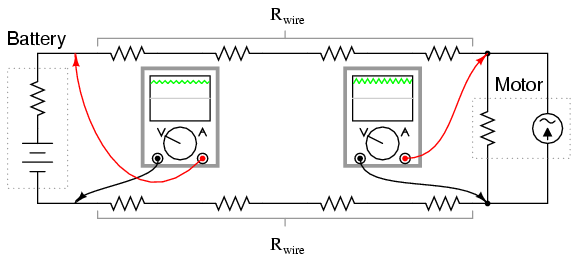
Use the audio detector to measure "noise"
voltage directly across the battery. Since the AC noise is
produced in this circuit by pulsating voltage drops along
stray resistances, the less resistance we measure across,
the less noise voltage we should detect:
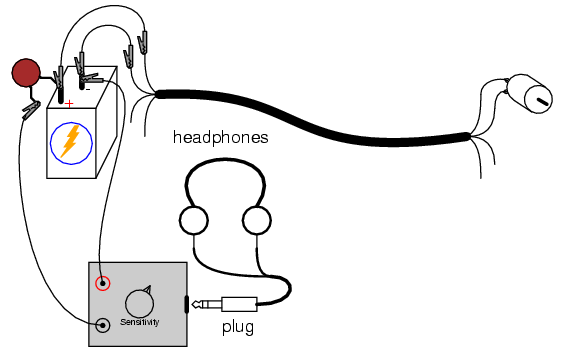
You may also measure noise voltage dropped
along either of the telephone cable conductors supplying
power to the motor, by connecting the audio detector between
both ends of a single cable conductor. The noise detected
here originates from current pulses through the resistance
of the wire:
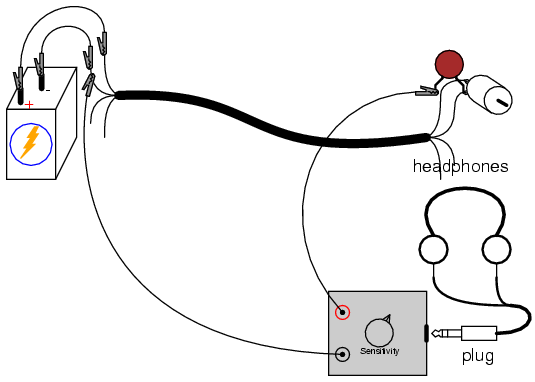
Now that we have established how AC noise is
created and distributed in this circuit, let's explore how
it is coupled to adjacent wires in the cable. Use the
audio detector to measure voltage between one of the motor
terminals and one of the unused wires in the telephone
cable. The 0.047 �F capacitor is not needed in this
exercise, because there is no DC voltage between these
points for the detector to detect anyway:
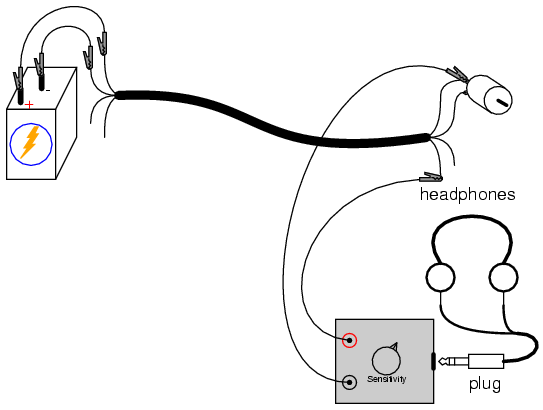
The noise voltage detected here is due to
stray capacitance between adjacent cable conductors creating
an AC current "path" between the wires. Remember that no
current actually goes through a capacitance, but the
alternate charging and discharging action of a capacitance,
whether it be intentional or unintentional, provides
alternating current a pathway of sorts.
If we were to try and conduct a voltage
signal between one of the unused wires and a point common
with the motor, that signal would become tainted with noise
voltage from the motor. This could be quite detrimental,
depending on how much noise was coupled between the two
circuits and how sensitive one circuit was to the other's
noise. Since the primary coupling phenomenon in this circuit
is capacitive in nature, higher-frequency noise voltages are
more strongly coupled than lower-frequency noise voltages.
If the additional signal was a DC signal,
with no AC expected in it, we could mitigate the problem of
coupled noise by "decoupling" the AC noise with a relatively
large capacitor connected across the DC signal's conductors.
Use the 0.22 �F capacitor for this purpose, as shown:
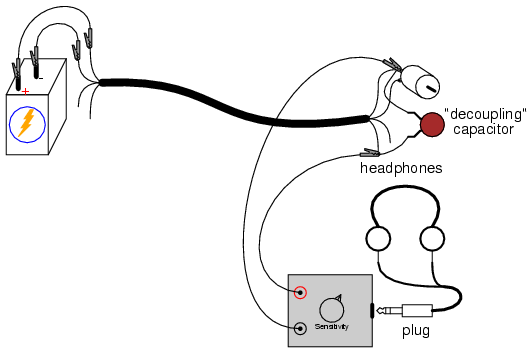
The decoupling capacitor acts as a
practical short-circuit to any AC noise voltage, while not
affecting DC voltage signals between those two points at
all. So long as the decoupling capacitor value is
significantly larger than the stray "coupling" capacitance
between the cable's conductors, the AC noise voltage will be
held to a minimum.
Another way of minimizing coupled noise in a
cable is to avoid having two circuits share a common
conductor. To illustrate, connect the audio detector between
the two unused wires and listen for a noise signal:
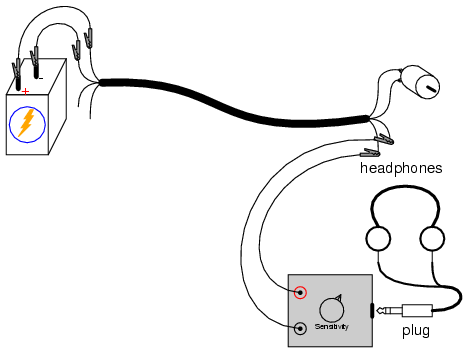
There should be far less noise detected
between any two of the unused conductors than between one
unused conductor and one used in the motor circuit. The
reason for this drastic reduction in noise is that stray
capacitance between cable conductors tends to couple the
same noise voltage to both of the unused
conductors in approximately equal proportions. Thus, when
measuring voltage between those two conductors, the
detector only "sees" the difference between two
approximately identical noise signals.
|